414. Pallid Swift Apus pallidus (Bruinwindswael)
Order: Apodiformes. Family: Apodidae
Description
16-17 cm. A pale brown swift with scaled underparts. Basically a brown bird with a greyish forehead and dark eye patch. Large white throat patch. Head and neck broad. Tail is short and forked. Long swept back wings. Outer primaries darker contrasting with inner primaries. From above, hindneck and rump are paler than mantle giving a saddle effect. From below, pale inner underwing contrasts with a darker wing tip.
Similar species: Very difficult to tell from African Black, Common and Bradfield's Swifts unless they are seen together. It differs from African Black Swift and Common Swift in being paler, with a more extensive white throat and paler forehead. Pallid Swift has less distinctive scaled underparts than Bradfields Swift.
Distribution
Breeds in the Mediterranean basin and the Middle East, heading south in the non-breeding season to the Sahel, from Gambia to Sudan. It is a rare vagrant to southern Africa, recorded once in Kuruman, Northern Cape on the 12th of February 1904.
Habitat
Aerial, spending most of their lives on the wing. It can occur in almost any mountainous or coastal habitat.
Diet
Flying insects.
Breeding
Pallid Swifts breed on cliffs and eaves around the Mediterranean and on the Canary Islands and Madeira, laying two eggs. The eggs are incubated for an average of 20 days.
Call
Disyllabic shree-er scream. Listen to Bird Call.
Status
Extremely rare vagrant to the sub-region.
Africa Wild Bird Book
Pallid Swift
Dewi
What is the good of having a nice house without a decent planet to put it on? (H D Thoreau)
What is the good of having a nice house without a decent planet to put it on? (H D Thoreau)
Pallid Swift Photos
414. Pallid Swift Apus pallidus
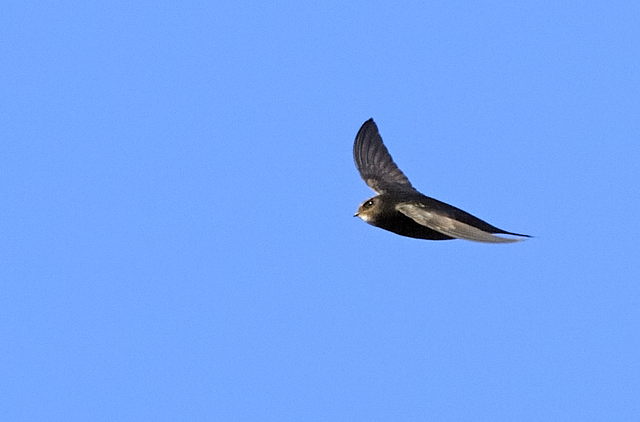

Dewi
What is the good of having a nice house without a decent planet to put it on? (H D Thoreau)
What is the good of having a nice house without a decent planet to put it on? (H D Thoreau)
-
Klipspringer
- Global Moderator
- Posts: 5862
- Joined: Sat Sep 14, 2013 12:34 pm
- Country: Germany
- Contact:
Bradfield's Swift
413. Bradfield's Swift Apus bradfieldi
Order: Apodiformes. Family: Apodidae
Description
A 17 cm; 33–50 g. A grey-brown or warm brown swift. Pale edges to breast feathers give underparts a scaled appearance. Primaries and secondaries of underwing are uniformly dark gray.
Similar species: Pallid Swift has less distinctive scaled underparts than Bradfield's Swift.
Distribution
Near endemic to southern Africa, occurring from south-western Angola to Namibia and the Northern Cape and W Free State. The core range of this species is in Namibia.
Habitat
Savanna, shrubland, rocky areas (eg. inland cliffs, mountain peaks), desert. It generally prefers arid habitats, such as desert and open savanna, often rocky, mountainous areas.
Diet
It forages in flocks, almost exclusively eating termite alates, bees and other flying insects.
Breeding
Its breeding habits are little known, however it is thought to be a monogamous colonial nester. The nest is a makeshift half cup, made of plant material and feathers glued together with saliva. They are usually grouped in colonies, often in rock crevices, buildings, mine workings and dead fronds of alien palm trees.
Call
High-pitched, shrill scream.
Order: Apodiformes. Family: Apodidae
Description
A 17 cm; 33–50 g. A grey-brown or warm brown swift. Pale edges to breast feathers give underparts a scaled appearance. Primaries and secondaries of underwing are uniformly dark gray.
Similar species: Pallid Swift has less distinctive scaled underparts than Bradfield's Swift.
Distribution
Near endemic to southern Africa, occurring from south-western Angola to Namibia and the Northern Cape and W Free State. The core range of this species is in Namibia.
Habitat
Savanna, shrubland, rocky areas (eg. inland cliffs, mountain peaks), desert. It generally prefers arid habitats, such as desert and open savanna, often rocky, mountainous areas.
Diet
It forages in flocks, almost exclusively eating termite alates, bees and other flying insects.
Breeding
Its breeding habits are little known, however it is thought to be a monogamous colonial nester. The nest is a makeshift half cup, made of plant material and feathers glued together with saliva. They are usually grouped in colonies, often in rock crevices, buildings, mine workings and dead fronds of alien palm trees.
Call
High-pitched, shrill scream.
-
Klipspringer
- Global Moderator
- Posts: 5862
- Joined: Sat Sep 14, 2013 12:34 pm
- Country: Germany
- Contact:
Bradfield's Swift Photos
413. Bradfield's Swift Apus bradfieldi
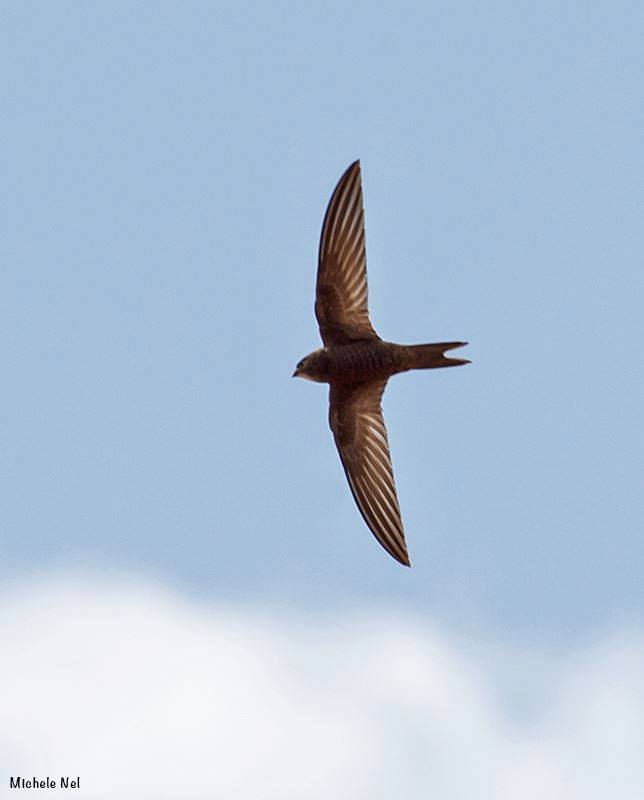 © Michele Nel
© Michele Nel
Kgalagadi Transfrontier Park, Rooiputs - 27/12/2016
Links
http://sabap2.birdmap.africa/docs/sabap1/413.pdf
http://www.biodiversityexplorer.info/bi ... fieldi.htm
 © Michele Nel
© Michele NelKgalagadi Transfrontier Park, Rooiputs - 27/12/2016
Links
http://sabap2.birdmap.africa/docs/sabap1/413.pdf
http://www.biodiversityexplorer.info/bi ... fieldi.htm
Little Swift
417. Little Swift Apus affinis (Kleinwindswael)
Order: Apodiformes. Family: Apodidae
Description
Length 12 cm. Weight 25 g. Sexes alike. Large white rump, which curls around the sides of the body, and square tail distinguish this species. The little swift is a very small bird, highly adapted to its aerial lifestyle, with long, narrow wings and a square-shaped tail. As the little swift spends most of the time gliding, rarely needing to flap its wings, this bird has a flat underside and weak breast muscles. The genus name Apus derives from the Greek ‘apous’ meaning ‘footless’, and actually refers to the short legs of the swift, which are so short and weak that, combined with its poorly developed breast muscles, the little swift avoids landing on the ground as it can be difficult to get back into the air. In contrast to its weak legs, the little swift has strong feet with incredibly sharp claws, used for clinging on to vertical surfaces.
Adult: Upperparts mostly brownish black. Forehead and lores grey-brown; supercilium narrow, whitish. Velvety black patch immediately in front of eye. Mantle and back glossy blue-black. Rump with broad white band (ca 15 mm) extending onto flanks, visible from below. Lower rump may show dark streaking when worn. Upper tail coverts grey-brown, tipped whitish. Tail dark grey-brown; short and square, appearing rounded when spread. Upper wing generally dark brown, blacker towards body; leading edge whitish. Most primaries and primary coverts fringed white when fresh; secondaries may have pale tips. Underside of flight feathers silvery grey. Underwing coverts and axillaries dull black or grey, narrowly fringed white. Chin and throat whitish, bordered dark brown, appearing grey and mottled when worn. Remainder of underparts dark brownish black, feathers fringed pale when fresh; pale bases visible when worn. Undertail silvery grey, appearing translucent when spread. Bill black. Eyes dark brown. Legs and feet purplish black.
Juveniles differ from adults and have a grey head and body with white-edged flight feathers.
Horus Swift may be confused with Little Swift, as both show a broad, white rump that wraps around the flanks, but Horus Swift is distinguished by its forked tail.
Distribution
The little swift is common and widespread throughout Asia and Africa. It also has a fragmented distribution in the Mediterranean.It occurs across sub-Saharan Africa, largely absent from Somalia. In southern Africa it is common in Namibia (excluding the Namib Desert), northern and eastern Botswana, Zimbabwe, Mozambique, Swaziland, Lesotho and South Africa.
Habitat
Found in a wide range of habitats, including forest, savanna, shrubland and grassland, the little swift build its nests on vertical surfaces such as cliffs and buildings. The prominent features of the little swift’s habitat are an abundant food supply and proximity to a water source.
Diet
Forages over water, grassland and shrubland for damselflies, dragonflies, flies, beetles, mosquitos, wasps, ants, butterflies, moths and spiders. Drinks water by skimming the water surface, wings held high.
Breeding
As with all swifts, the little swift forms monogamous breeding pairs, with each pair laying one to three eggs, which are incubated for 22 to 24 days. The breeding pair is capable of 'double-clutching', which means that if the first clutch of eggs is lost they will produce a second to replace it. The nest of the little swift is robust and messy-looking outside, but smooth and neat inside. It is hemispherical in shape and built from grass, small twigs, down and feathers, which are glued together with saliva. Nests are built in groups of up to 30, and two to three females may lay their eggs in a shared nest. The breeding season of this bird depends on the location and the weather.
Call
Noisy, especially around br sites; call a shrill scream. Listen to Bird Call.
Status
Common resident with partial migrant populations that are absent in mid-winter. Classified as Least Concern (LC) on the IUCN Red List.
Order: Apodiformes. Family: Apodidae
Description
Length 12 cm. Weight 25 g. Sexes alike. Large white rump, which curls around the sides of the body, and square tail distinguish this species. The little swift is a very small bird, highly adapted to its aerial lifestyle, with long, narrow wings and a square-shaped tail. As the little swift spends most of the time gliding, rarely needing to flap its wings, this bird has a flat underside and weak breast muscles. The genus name Apus derives from the Greek ‘apous’ meaning ‘footless’, and actually refers to the short legs of the swift, which are so short and weak that, combined with its poorly developed breast muscles, the little swift avoids landing on the ground as it can be difficult to get back into the air. In contrast to its weak legs, the little swift has strong feet with incredibly sharp claws, used for clinging on to vertical surfaces.
Adult: Upperparts mostly brownish black. Forehead and lores grey-brown; supercilium narrow, whitish. Velvety black patch immediately in front of eye. Mantle and back glossy blue-black. Rump with broad white band (ca 15 mm) extending onto flanks, visible from below. Lower rump may show dark streaking when worn. Upper tail coverts grey-brown, tipped whitish. Tail dark grey-brown; short and square, appearing rounded when spread. Upper wing generally dark brown, blacker towards body; leading edge whitish. Most primaries and primary coverts fringed white when fresh; secondaries may have pale tips. Underside of flight feathers silvery grey. Underwing coverts and axillaries dull black or grey, narrowly fringed white. Chin and throat whitish, bordered dark brown, appearing grey and mottled when worn. Remainder of underparts dark brownish black, feathers fringed pale when fresh; pale bases visible when worn. Undertail silvery grey, appearing translucent when spread. Bill black. Eyes dark brown. Legs and feet purplish black.
Juveniles differ from adults and have a grey head and body with white-edged flight feathers.
Horus Swift may be confused with Little Swift, as both show a broad, white rump that wraps around the flanks, but Horus Swift is distinguished by its forked tail.
Distribution
The little swift is common and widespread throughout Asia and Africa. It also has a fragmented distribution in the Mediterranean.It occurs across sub-Saharan Africa, largely absent from Somalia. In southern Africa it is common in Namibia (excluding the Namib Desert), northern and eastern Botswana, Zimbabwe, Mozambique, Swaziland, Lesotho and South Africa.
Habitat
Found in a wide range of habitats, including forest, savanna, shrubland and grassland, the little swift build its nests on vertical surfaces such as cliffs and buildings. The prominent features of the little swift’s habitat are an abundant food supply and proximity to a water source.
Diet
Forages over water, grassland and shrubland for damselflies, dragonflies, flies, beetles, mosquitos, wasps, ants, butterflies, moths and spiders. Drinks water by skimming the water surface, wings held high.
Breeding
As with all swifts, the little swift forms monogamous breeding pairs, with each pair laying one to three eggs, which are incubated for 22 to 24 days. The breeding pair is capable of 'double-clutching', which means that if the first clutch of eggs is lost they will produce a second to replace it. The nest of the little swift is robust and messy-looking outside, but smooth and neat inside. It is hemispherical in shape and built from grass, small twigs, down and feathers, which are glued together with saliva. Nests are built in groups of up to 30, and two to three females may lay their eggs in a shared nest. The breeding season of this bird depends on the location and the weather.
Call
Noisy, especially around br sites; call a shrill scream. Listen to Bird Call.
Status
Common resident with partial migrant populations that are absent in mid-winter. Classified as Least Concern (LC) on the IUCN Red List.
Little Swift Photos
417. Little Swift Apus affinis
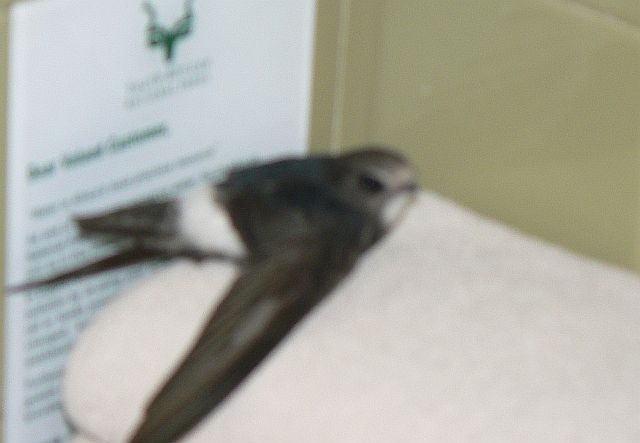 © Toko
© Toko
Little Blurred

 Kruger National Park
Kruger National Park
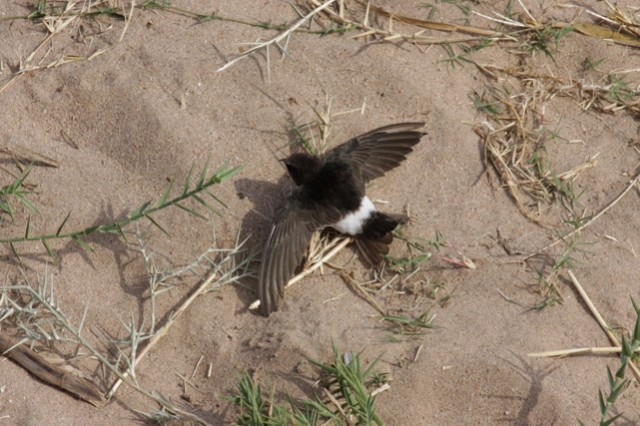 © leachy
© leachy
Kruger National Park, Olifants River bridge
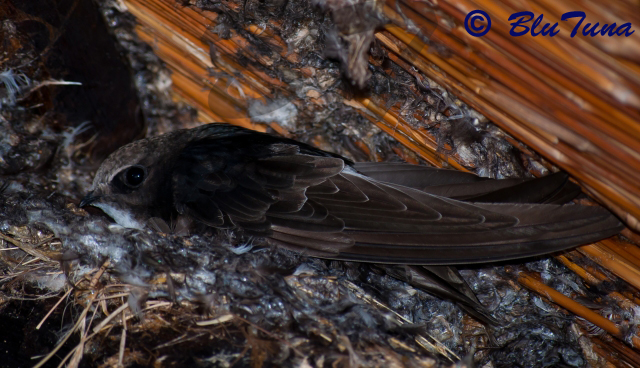 © BluTuna
© BluTuna
Kruger National Park
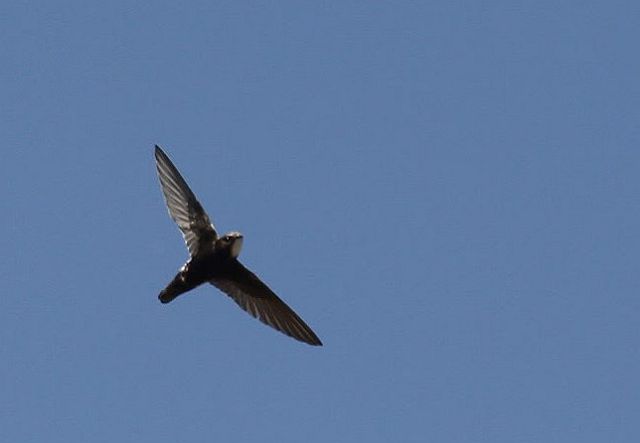 © leachy
© leachy
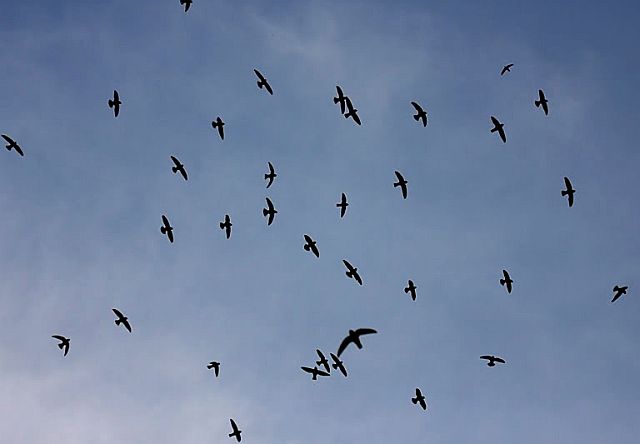 © leachy
© leachy
 © Flutterby
© Flutterby
Links:
Species text Sabap1
Sabap2
 © Toko
© TokoLittle Blurred
 © leachy
© leachyKruger National Park, Olifants River bridge
 © BluTuna
© BluTunaKruger National Park
 © leachy
© leachy © leachy
© leachy © Flutterby
© FlutterbyLinks:
Species text Sabap1
Sabap2
ORDER COLIIFORMES Family Coliidae (Mousebirds)
The mousebirds are a small group of (possibly near passerine) birds, which have no known close affinities to other groups, though might be close to trogons and owls. The mousebirds are therefore given order status as Coliiformes. This group is confined to sub-Saharan Africa, and is the only bird order confined entirely to that continent.
They are slender greyish or brown birds with soft, hairlike body feathers. They are typically about 10 cm in body length, with a long, thin tail a further 20–24 cm in length, and weigh 45–55 grams. They are arboreal and scurry through the leaves like rodents, in search of berries, fruit and buds. This habit, and their legs, gives rise to the group's English name. They are acrobatic, and can feed upside down. All species have strong claws and reversible outer toes (pamprodactyl foot). They also have crests and stubby bills.
Mousebirds are gregarious, again reinforcing the analogy with mice, and are found in bands of about 20 in lightly wooded country. These birds build cup-shaped twig nests in trees, which are lined with grasses. Two to four eggs are typically laid, hatching to give atricial young which develop quickly and soon leave the nest and acquire flight.
They are all non-migratory. Mousebirds feed on fruit, buds and leaves of a variety of vegetation. They are a pest of fruit crops in some areas of Africa especially as they eat the buds as well as the fruit.
They are slender greyish or brown birds with soft, hairlike body feathers. They are typically about 10 cm in body length, with a long, thin tail a further 20–24 cm in length, and weigh 45–55 grams. They are arboreal and scurry through the leaves like rodents, in search of berries, fruit and buds. This habit, and their legs, gives rise to the group's English name. They are acrobatic, and can feed upside down. All species have strong claws and reversible outer toes (pamprodactyl foot). They also have crests and stubby bills.
Mousebirds are gregarious, again reinforcing the analogy with mice, and are found in bands of about 20 in lightly wooded country. These birds build cup-shaped twig nests in trees, which are lined with grasses. Two to four eggs are typically laid, hatching to give atricial young which develop quickly and soon leave the nest and acquire flight.
They are all non-migratory. Mousebirds feed on fruit, buds and leaves of a variety of vegetation. They are a pest of fruit crops in some areas of Africa especially as they eat the buds as well as the fruit.
Family Coliidae (Mousebirds) Index
ORDER COLIIFORMES
Family Coliidae (Mousebirds)
Colius striatus Speckled Mousebird 424
Colius colius White-backed Mousebird 425
Urocolius indicus Red-faced Mousebird 426
Family Coliidae (Mousebirds)
Colius striatus Speckled Mousebird 424
Colius colius White-backed Mousebird 425
Urocolius indicus Red-faced Mousebird 426
Speckled Mousebird
424. Speckled Mousebird Colius striatus (Gevlekte Muisvoël)
Order: Coliiformes. Family: Coliidae
Description
Size 35 cm, the tail comprising approximately half the length. Dull-mousy brown, bill is black on the upper part and is pinkish on the lower, black face, grey head with a prominent crest, the eyes black and the legs and feet are purplish-brown or black. The sexes are alike in plumage and in size.
Juvenile resembles adult, but lacks black on the face.
Similar species: The rare White-headed Mousebird can be confused with this species, but the differently colored mandibles and the lack of a bare grey orbital patch render the Speckled species distinctive. The Speckled Mousebird has dark, almost black legs, which separate it from the Red-faced Mousebird and White-backed Mousebird, both of which have pink to red legs.
Distribution
The most widely distributed of the mousebirds in Africa. Occurs from Cameroon to Ethiopia south, through southern DRC, Tanzania, northern Zambia and northern Angola to southern Africa. Within southern Africa it is common in eastern Zimbabwe, Mozambique and South Africa, largely excluding the arid Northern Cape, it has a mainly eastern and southern range in southern Africa.
Habitat
It is very adaptable, occurring in forest edges, thickets, gardens, orchards, strandveld, riverine woodland and alien tree plantations.
Diet
It feeds on a wide variety of plant matter, especially fruit but also flowers, nectar, leaves, buds and dead bark. It usually forages in the mid to upper tree canopy, often in groups of 5-20 birds.
Behaviour
These are conspicuously social birds, feeding together and engaging in mutual preening. They also accompany each other when they go to ground to dust bathe (also to occasionally to swallow pebbles to assist in grinding up vegetation as they digest it). Upon nightfall, they roost in very tight groups of 20 or so birds and on cold nights they can become torpid. Being in a torpid state could make them easy prey, but the large groups are apparently effective enough to deter most nocturnal predators.
Breeding
Can be monogamous or polygamous, meaning that the male can have one ore multiple mates. It is also a cooperative breeder, with 2-6 juvenile helpers, some of which are not related to the breeding couple. Courtship is fairly elaborate, with preening, bouncing up and down on perch and exchanging of food. The nest is a small, shallow bowl made of grass and herb stems, lined with soft material. It is typically placed 1-7m above ground in a tree or bush. Egg-laying season is from July-April, peaking from September-January. It lays 1-7, usually 2-4 eggs, which are incubated by both sexes for 12-15 days. The pair change over every 0.5-2.0 hours, accompanied with a ritual display in which they both show open their beaks to show their gape. The chicks are fed by both parents on a diet of regurgitated plant material mixed with the chick's faeces, that the parents had eaten previously. The nestlings start to explore the branches surrounding the nest at about 10-11 days old, after which they start to preen each other. They stay in the nest 15-20 days, after which they become independent.
Call
Highly vocal especially when disturbed. Most frequent call sharp chee chee chee. Alarm call zik zik. Listen to Bird Call.
Status
Very common resident.
Order: Coliiformes. Family: Coliidae
Description
Size 35 cm, the tail comprising approximately half the length. Dull-mousy brown, bill is black on the upper part and is pinkish on the lower, black face, grey head with a prominent crest, the eyes black and the legs and feet are purplish-brown or black. The sexes are alike in plumage and in size.
Juvenile resembles adult, but lacks black on the face.
Similar species: The rare White-headed Mousebird can be confused with this species, but the differently colored mandibles and the lack of a bare grey orbital patch render the Speckled species distinctive. The Speckled Mousebird has dark, almost black legs, which separate it from the Red-faced Mousebird and White-backed Mousebird, both of which have pink to red legs.
Distribution
The most widely distributed of the mousebirds in Africa. Occurs from Cameroon to Ethiopia south, through southern DRC, Tanzania, northern Zambia and northern Angola to southern Africa. Within southern Africa it is common in eastern Zimbabwe, Mozambique and South Africa, largely excluding the arid Northern Cape, it has a mainly eastern and southern range in southern Africa.
Habitat
It is very adaptable, occurring in forest edges, thickets, gardens, orchards, strandveld, riverine woodland and alien tree plantations.
Diet
It feeds on a wide variety of plant matter, especially fruit but also flowers, nectar, leaves, buds and dead bark. It usually forages in the mid to upper tree canopy, often in groups of 5-20 birds.
Behaviour
These are conspicuously social birds, feeding together and engaging in mutual preening. They also accompany each other when they go to ground to dust bathe (also to occasionally to swallow pebbles to assist in grinding up vegetation as they digest it). Upon nightfall, they roost in very tight groups of 20 or so birds and on cold nights they can become torpid. Being in a torpid state could make them easy prey, but the large groups are apparently effective enough to deter most nocturnal predators.
Breeding
Can be monogamous or polygamous, meaning that the male can have one ore multiple mates. It is also a cooperative breeder, with 2-6 juvenile helpers, some of which are not related to the breeding couple. Courtship is fairly elaborate, with preening, bouncing up and down on perch and exchanging of food. The nest is a small, shallow bowl made of grass and herb stems, lined with soft material. It is typically placed 1-7m above ground in a tree or bush. Egg-laying season is from July-April, peaking from September-January. It lays 1-7, usually 2-4 eggs, which are incubated by both sexes for 12-15 days. The pair change over every 0.5-2.0 hours, accompanied with a ritual display in which they both show open their beaks to show their gape. The chicks are fed by both parents on a diet of regurgitated plant material mixed with the chick's faeces, that the parents had eaten previously. The nestlings start to explore the branches surrounding the nest at about 10-11 days old, after which they start to preen each other. They stay in the nest 15-20 days, after which they become independent.
Call
Highly vocal especially when disturbed. Most frequent call sharp chee chee chee. Alarm call zik zik. Listen to Bird Call.
Status
Very common resident.
Speckled Mousebird Photos
424. Speckled Mousebird Colius striatus
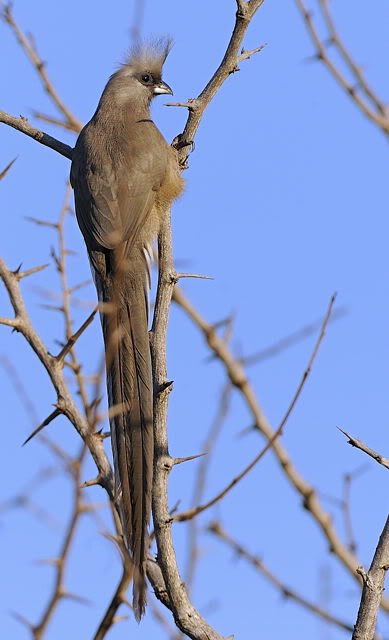 © Dewi
© Dewi
KZN
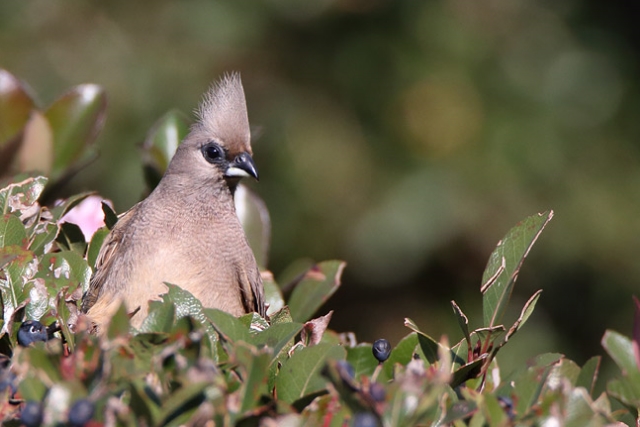 © PJL
© PJL
Garden Port Elizabeth, Eastern Cape
 © BluTuna
© BluTuna
 © Mel
© Mel
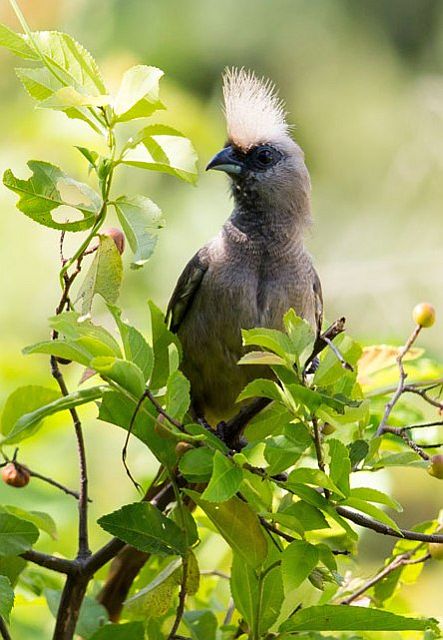 © Pumbaa
© Pumbaa
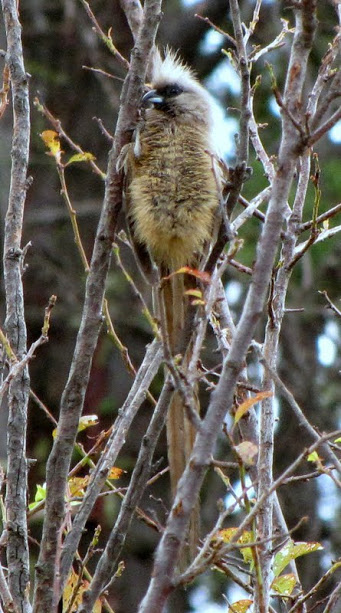 © Lisbeth
© Lisbeth
Links:
Species text in The Atlas of Southern African Birds
Sabap2
 © Dewi
© DewiKZN
 © PJL
© PJLGarden Port Elizabeth, Eastern Cape
 © BluTuna
© BluTuna © Mel
© Mel © Pumbaa
© Pumbaa  © Lisbeth
© LisbethLinks:
Species text in The Atlas of Southern African Birds
Sabap2


